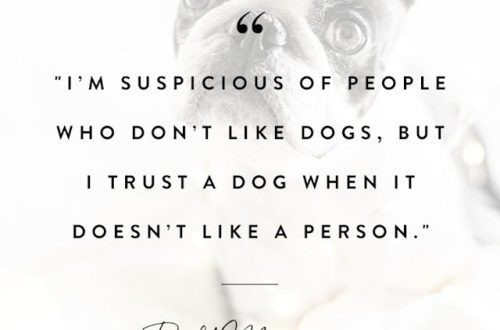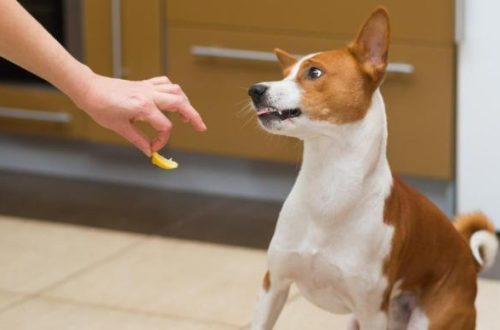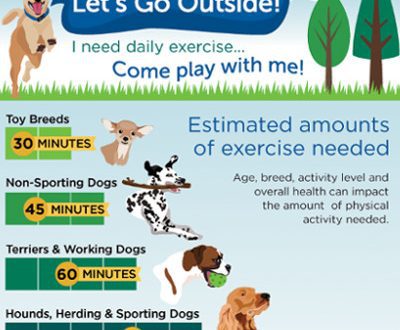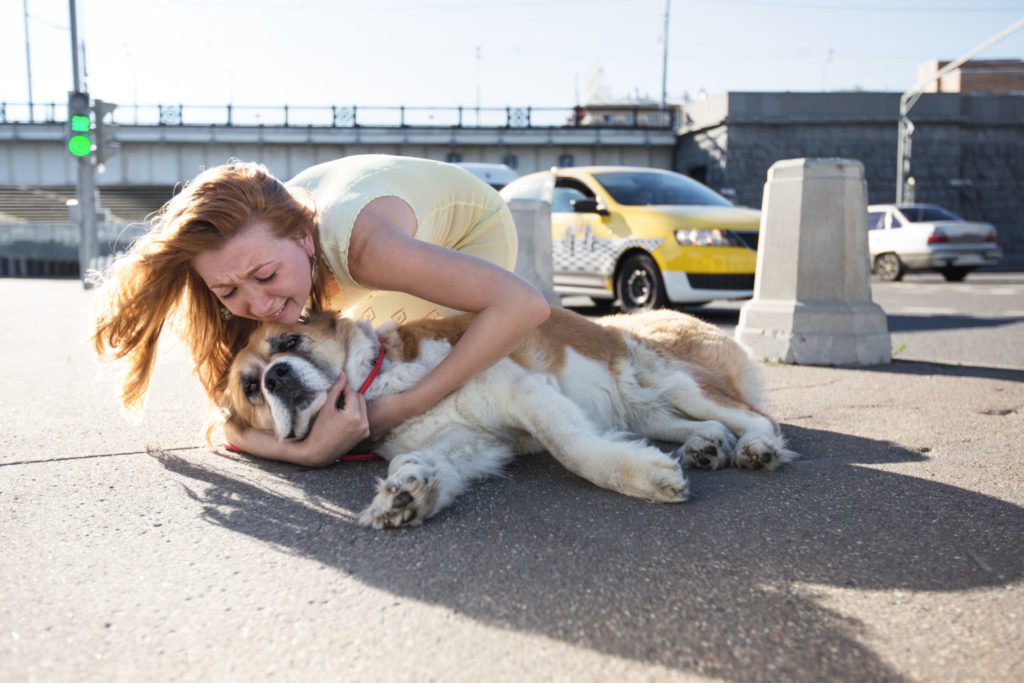
The dog was hit by a car: what can be done?
No one wants to be in this situation, but, unfortunately, this happens quite often with animals. If the dog was hit by a car, how to help her – in this article.
Contents
What to do if your dog is hit by a car?
 Any person who finds himself in a similar situation, whether it be the owner of the dog, the driver of the car or an outside observer, will want to help the animal, but care should be taken in helping the animal. Moving an injured animal can make the situation worse. In addition, an injured, frightened, or disoriented dog may bite those who try to help it. To approach an animal that was hit by a car and help him, you need to follow these steps:
Any person who finds himself in a similar situation, whether it be the owner of the dog, the driver of the car or an outside observer, will want to help the animal, but care should be taken in helping the animal. Moving an injured animal can make the situation worse. In addition, an injured, frightened, or disoriented dog may bite those who try to help it. To approach an animal that was hit by a car and help him, you need to follow these steps:
- Keep calm. It can be difficult to control emotions, especially if it’s your dog, but it’s important not to panic. Keeping a clear mind will help not only you and those who are trying to help, but also the injured animal. Dogs pick up on their owners’ emotions and use them in their own reactions. Exposure will calm the pet and prevent panic and aggressive behavior.
- Call the police or the veterinary and phytosanitary supervision service. As PetHelpful notes, this is the responsibility of the driver, who must remain in place until help arrives. If the perpetrator simply leaves the animal on the road without calling for help or attempting to provide assistance, this may be considered as leaving the scene of an accident, which will lead to a charge of animal cruelty to the driver. Even if the owner of the dog is at the scene of the accident, it is usually recommended that the driver call the help desk, who can give more complete answers to questions. When calling the help desk, you need to ask the operator what he recommends doing. These tips will help you not to get confused, but it is better to follow the instructions of specialists who can give other recommendations depending on the specific situation.
- Put a muzzle on your dog to prevent biting. This should only be done if the dog is not vomiting. You can also use a stocking, towel or gauze instead of a muzzle if it is not at hand. Small dogs can be wrapped entirely in a towel or blanket – just do it carefully, not too tight, but so that the dog moves less.
- If necessary, you need to move the dog out of the way, but carefully and if there is no risk to your own safety. Otherwise, you should wait for the arrival of help. To move a large dog, you need to carefully place a piece of plywood, a blanket or a towel under it. All this should be used as a stretcher to slowly and carefully lift the dog and carry it to the side of the road.
- Check identification data. If the owner of the dog is not at the scene, you should try to contact him or the veterinarian listed on the dog’s tag. If identification is missing and the owner cannot be located, wait for the police and animal control to arrive.
When the owner is found, he will decide where to take the dog for emergency veterinary care. If the owner of the animal cannot be found, the driver or any other caring person can take the dog to the veterinarian.
It is important to remember that if you put a dog in a car, you will have to take responsibility for it and probably pay for treatment. Perhaps these expenses will be reimbursed by the owner of the dog when he is found. If it is not possible to pay for the treatment of a pet, it is better to let the police sort it out.
Who is responsible for paying the costs?
Liability laws vary from country to country, but in most cases, the owner of the dog is responsible for paying for veterinary treatment and repairing damage to the driver’s vehicle.
Such rules may seem unfair. But they are justified by the fact that it is the owners who are obliged to restrict the movement of their pets and keep them away from the road. The exceptions are cases where it can be proven that the driver drove the car recklessly or intentionally hit the dog. Then the responsibility for the treatment or reimbursement of the cost of the animal may be placed on the driver. The vehicle owner can file a claim with their auto insurer.
If the dog seems to be doing well
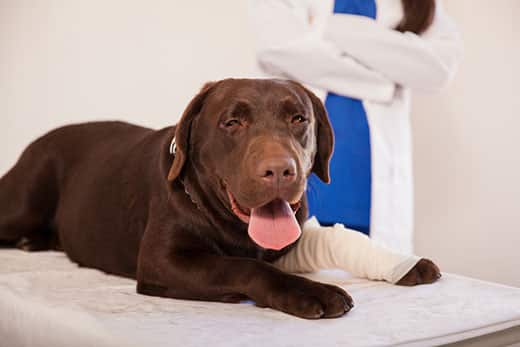 A dog hit by a car may not have visible injuries and may look quite normal. But it should be remembered that some serious internal injuries do not have any external manifestations. In such a situation, it is best to let the veterinarian assess the condition of the dog. Even in the case of a minor incident, the animal should be taken for inspection. If the owner of the dog is not at the scene, it is best to wait for the arrival of professional help to assess the situation and the condition of the animal. Some signs to look out for to help your veterinarian assess your dog’s condition are:
A dog hit by a car may not have visible injuries and may look quite normal. But it should be remembered that some serious internal injuries do not have any external manifestations. In such a situation, it is best to let the veterinarian assess the condition of the dog. Even in the case of a minor incident, the animal should be taken for inspection. If the owner of the dog is not at the scene, it is best to wait for the arrival of professional help to assess the situation and the condition of the animal. Some signs to look out for to help your veterinarian assess your dog’s condition are:
- Cardiopalmus.
- Shallow breathing.
- Black stool or diarrhea.
- Pale or blue gums.
- Поскуливание
- Cough or vomit blood.
- Depression or lethargy.
- Glassy or defocused eyes.
- Bruises or scratches.
- Loss of consciousness or coma.
Treating a dog hit by a car
As PetHelpful explains, first of all, specialists at the clinic will try to stabilize her condition. Before dealing with injuries, it is necessary to prevent shock and only then provide any other medical care. The veterinarian will take care to stop any internal bleeding, prevent a heart attack, and keep the dog from falling into a coma. Only after the dog’s condition has stabilized will doctors begin to assess and treat the injuries it has sustained.
Depending on the extent of the injury, the dog may need hospitalization, surgery, or special treatment. Pet health insurance can help reduce the costs associated with life-saving care and recovery. As soon as the dog recovers and all of its injuries have healed, you can take it home. Your veterinarian will provide instructions on how to care for your pet at home and any medications needed to relieve pain and speed up healing.
How to protect your dog from getting into an accident
Even if the dog is very smart or well trained, you should not rely on his skills or that he understands that he should not throw himself under cars. The only way to ensure that the animal stays off the road is to physically restrict its movements, that is, walking on a leash or in a fenced area.
It is necessary to strengthen the fence so that the dog cannot escape. Obedience training will help teach her not to jump out into the street recklessly, dragging the owner behind her or tearing the leash out of her hands. Finally, while walking, it is recommended to carefully monitor what is happening around – look and listen to the movement of cars and hold the leash tightly.
Regardless of how an accident occurs, it is a traumatic experience for everyone involved. Calmness and quick, careful actions can increase a dog’s chances of survival.



